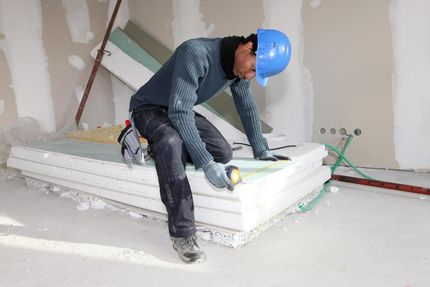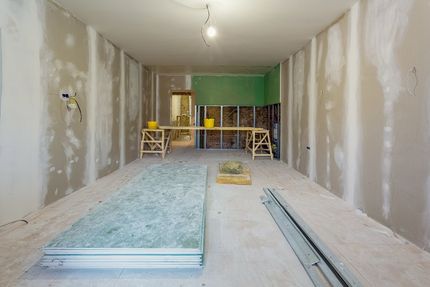Full Overview to Dependable and reliable Drywall Installment
Drywall installment is a crucial element of any type of construction or renovation task, requiring a thorough strategy to make certain both efficiency and dependability. Understanding the essential tools and techniques is critical, as well as identifying typical pitfalls that can result in subpar results. By carefully preparing the area and implementing ideal methods, one can attain a perfect surface that stands the examination of time. It is necessary to explore the nuances of each step in the procedure, as they jointly contribute to the overall success of the drywall setup. What specific methods can boost your technique?
Essential Devices for Drywalling
When starting a drywall setup task, having the right devices is important for achieving a professional finish. Crucial tools consist of a drywall blade, measuring tape, and a T-square, which are fundamental for precise measurements and smooth cuts. A drywall lift is also highly valuable, especially for ceiling installments, enabling easier handling of heavy panels.
For fastening the drywall, a cordless drill and drywall screws are necessary. The drill needs to be geared up with a drywall bit to make certain efficiency and precision. In addition, an essential device is the drywall saw, which facilitates cutting about other barriers and electric outlets.

Furthermore, protective equipment such as shatterproof glass and a dirt mask are essential to guarantee personal security throughout the installment procedure. Using the right devices not only boosts the top quality of the installment but likewise streamlines the workflow, making the job much more effective general.
Preparing the Space

Next, assess the condition of the ceilings and wall surfaces. Repair any type of existing damages, such as openings, splits, or peeling off paint, to make sure a smooth and also surface area for drywall application. Furthermore, check for electric outlets, plumbing lines, and a/c air ducts, noting their places to avoid issues throughout installment.
It is additionally critical to gauge the space accurately, figuring out the measurements of the walls and ceilings to compute the appropriate amount of drywall needed. Develop an in-depth plan that consists of the layout and alignment of the drywall panels.
Installment Strategies
Reliable installation methods are vital for attaining an expert surface in drywall tasks. Appropriate measurement and cutting of drywall sheets are basic actions.
When hanging drywall, begin with the leading and job downward, making sure that the lengthy side of the board is perpendicular to the framing. Safeguard the sheets with screws instead than nails, which provide greater holding power and minimize the risk of popping. Place screws every 12 inches along the sides and every 16 inches in the field of the board.
For edges, utilize corner beads to accomplish sharp, tidy edges. When installing on ceilings, utilize a drywall lift or have a partner help in holding the sheets in place (drywall contractor). Keep a space of regarding 1/4 inch above the floor and ceiling to suit growth and tightening
Ending Up Touches

As soon as the tape is in location, it's time to apply the initial layer of joint compound, likewise understood as mud. Use a 10 to 12-inch taping blade to spread the compound uniformly over the taped seams, feathering the sides to blend with the surrounding drywall.
Enable the compound to dry completely, usually 1 day. After drying out, sand the surface area lightly with fine-grit sandpaper to eliminate any kind of blemishes. drywall repair. Repeat the mudding and fining sand Check This Out procedure, usually a couple of coats, making sure each layer is smooth and flush with the drywall surface area
Common Mistakes to Stay Clear Of
Many do it yourself enthusiasts encounter risks during drywall installment that can endanger the results. One typical mistake is failing to properly reduce and measure drywall sheets. Inaccurate cuts can lead to voids and irregular seams, making finishing more labor-intensive. In addition, ignoring to surprise joints can produce weak factors in the wall surface, resulting in prospective sagging or fracturing gradually.
An additional frequent mistake is inappropriate fastening. Utilizing too few screws or nails can lead to loosened drywall, while overdriving bolts can create the paper to tear, damaging the framework. It's important to maintain resource constant spacing, typically every 16 inches, and to ensure that bolts are flush with the surface area.
Additionally, not addressing wetness concerns prior to setup can result in mold growth and architectural damage. Always examine the environment and use moisture-resistant drywall in high-humidity locations.
Final Thought
Reliable and reputable drywall installment requires careful focus to detail throughout the process. By using necessary tools, preparing the room effectively, and adhering to best practices in installation techniques, a perfect surface can be accomplished. In addition, cautious application of joint substance and tape throughout the completing stage improves durability and appearance. Staying clear of common mistakes additionally contributes to a professional outcome, underscoring the relevance of accuracy and strategy in successful drywall jobs.
It is important to check out the nuances of each action in the process, as they jointly add to the general success of the drywall setup.When embarking on a drywall installation task, having the right devices is important for accomplishing an expert coating.For fastening the drywall, a cordless drill and drywall screws are essential.Correctly preparing the room is vital for an effective drywall setup.Efficient installation methods are essential for accomplishing an expert surface in drywall tasks.